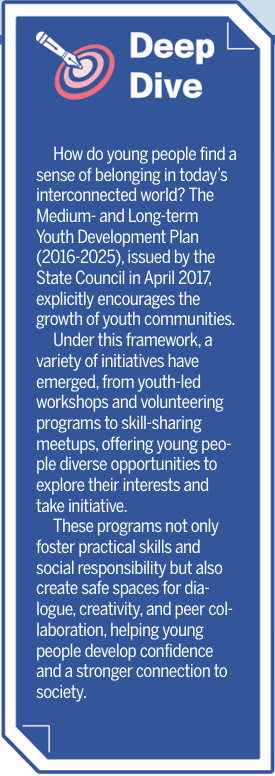Peer connections inspire learning and growth


Over the past decade, the organization of youth communities has changed significantly. Once centered mainly on offline gatherings like book clubs, these communities are now increasingly digital, becoming more flexible and interconnected online. They have moved beyond simple information sharing to become spaces where young people can express ideas and explore their identities.
Many youth communities are born out of shared interests, common lifestyles, trending topics, or cultural symbols serving as social bonds. These groups can form quickly and may dissolve as interests shift, yet they provide young people with a wider range of opportunities for connection and self-expression.
Skilled young people seeking flexible employment often contribute actively to these communities, turning them into platforms for honing skills and expanding professional and social networks.
Another notable trend is the influence of young returnees. Having experience building connections through associations abroad, they bring this expertise home, initiating entrepreneurial projects, cultural exchanges, and collaborative activities that foster cross-cultural dialogue and interactions.
Together, these trends define today's youth communities as compact, diverse, and open.
I believe that, at their core, youth communities are about value, ideas, and growth. Young people join these groups seeking skills, insights, and meaningful engagement. When a community offers little more than a waste of time, participation quickly fades. At their best, these communities facilitate exchange and personal development, leaving members with lasting takeaways.
Peer-to-peer sharing is central to this kind of growth. Young people are more easily inspired by the stories and attitudes of their peers, especially those with similar interests or backgrounds. This dynamic within communities nurtures both confidence and direction.
While youth communities share fundamental traits, they evolve differently across regions. In economically strong cities, better services and supportive policies encourage young people to shift their focus from mere leisure to deeper fulfillment. When paired with a rich humanistic environment and talent-friendly policies, these cities provide fertile ground for communities to grow — both institutionally and culturally.
In such cities, communities often blend naturally with local culture. In Shanghai, for example, a young organizer leads urban heritage walks, combining the preservation of Shikumen — the city's traditional stone-gate houses — with innovative social activities. These small, agile communities not only inspire public-mindedness but also help young people find a sense of purpose through hands-on experience.
By contrast, smaller cities and counties, though less resource-dense, are nurturing new types of communities. Young people gather at guesthouses or scenic sites around shared interests or work, forming temporary yet close-knit groups.
In Minqin county, Gansu province, for example, I met university students who had organized themselves to plant trees in the desert, forging lasting bonds through this collective effort.
Some communities even transcend geography, such as volunteer subtitling groups and mutual-aid networks. In a mental health support group I organized, volunteers who had never met in person came together through a shared sense of responsibility and care. These digital communities allow voices from smaller cities to reach national — and even global — audiences, finding both support and resonance.
I believe a community's vitality depends not on the size of a city, but on its ability to offer young people genuine value and a sense of belonging. Across both major cities and remote counties, youth are discovering opportunities for growth, spaces for expression, and intersections between personal interests and public responsibility. From this foundation, new collective energies are steadily taking shape.
Written by Li Lei, standing member of the All-China Youth Federation, and founder and CEO of Yi She Public Welfare. With over a decade of NGO entrepreneurship experience, he has long focused on innovative social governance, actively engages in volunteer work, and encourages more young people to participate in community building.
How do young people find a sense of belonging in today's interconnected world? The Medium- and Long-term Youth Development Plan (2016-2025), issued by the State Council in April 2017, explicitly encourages the growth of youth communities.
Under this framework, a variety of initiatives have emerged, from youth-led workshops and volunteering programs to skill-sharing meetups, offering young people diverse opportunities to explore their interests and take initiative.
These programs not only foster practical skills and social responsibility but also create safe spaces for dialogue, creativity, and peer collaboration, helping young people develop confidence and a stronger connection to society.





































